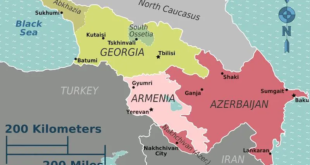 US officials tried to build a force that could not stand up to Russia, but now they may have to.
US officials tried to build a force that could not stand up to Russia, but now they may have to.
Â
In the aftermath of Russia’s swift victory over the Georgian Army, Prime Minister Vladimir Putin has suggested that the United States secretly provoked the conflict-perhaps even prepared Georgia’s forces for it. Lt. Col. Robert Hamilton, who ran the US military training program in Georgia until six weeks ago, finds the charge ironic. “At no time did the US attempt to train or equip the Georgian armed forces for a conflict with Russia,” he says. “In fact, the US deliberately avoided training capabilities that were seen as too provocative” to Russia. So the United States never trained the Georgians how to use tanks,
artillery or attack helicopters-precisely because those are the skills of all-out conventional warfare. Now the United States-with or without its European allies-is being pushed to build a Georgian Army that could face the Russians, next time.
US military involvement in Georgia grew step by step. In a further irony, it began with a mission designed to placate Russia. The Russians, battling to crush the revolt in Chechnya, complained that Chechen fighters were holed up in a border area of Georgia, the Pankisi Gorge. Washington believed some had ties to Al Qaeda. Georgia’s forces were too weak to oust the Chechens, so in 2002 the Pentagon stepped in, training and equipping three Georgian infantry battalions. “We had to give them everything, even uniforms and boots,” one veteran of that effort recalls. Still, the raw units were good enough to clear the Pankisi area, removing, or so Washington hoped, an irritant in Russian-Georgian relations.
That program ended in spring 2004. Then Georgia, keen to foster its new military ties with the United States, proposed contributing some of those troops to the Coalition in Iraq. Since July 2005 the United States has trained an additional three Georgian brigades for Baghdad and equipped them with US gear: armored Humvees, devices to detect roadside IEDs, radios and other basics. By Pentagon standards, it was a bare-bones effort: a training mission of about 130 troops, at a cost since 2002 of no more than 0 million. A French diplomat in Tbilisi says the United States gave the Georgians the equivalent of about a month of French basic training-nothing near what they would need to stand up to Russia.Â
Georgia did make its own efforts. As its economy boomed under President Mikheil Saakashvili, its defense budget grew from million in 2003 to more than 0 million last year, but without US support for the creation of heavy-combat forces, it bought old but serviceable Soviet T-72 tanks from Ukraine and howitzers from the Czech Republic. Georgia ran a heavy-arms exercise two summers ago, but it was a rerun of the carefully pre-scripted Soviet-style maneuvers of a generation past. When the Russians invaded last month, the performance of Georgia’s Soviet-era tank and artillery was “primitive,” according to a preliminary analysis by the US Army.
Now Georgians are already talking of building a newer, better, bigger military to protect themselves from Russian aggression. They say this should be a concerted Western effort, and senior US military officials affirm they are prepared to discuss with Georgia how its military might be rebuilt. But in Tbilisi last week, Vice President Dick Cheney promised that “America will help Georgia to rebuild and regain its position as one of the world’s fastest growing economies,” while remaining carefully unspecific about military aid.
Georgia’s military reconstruction raises tough questions. Technically, it would be reasonably straightforward to equip Georgia’s forces in a fashion that was clearly for defensive purposes only. Hamilton has sketched how in a brief paper just published by the Center for Strategic & International Studies: “The capabilities required include secure command and control systems, an integrated air-defense … system, a robust maritime defense capability, counterartillery radar systems and a highly-lethal anti-armor capability.” Weapons, in other words, to exact a toll on any tanks, warships, aircraft or artillery advancing on Georgia-but not the heavy weaponry enabling a Georgian advance on its neighbors.
Â
But Russia’s potential reaction is, of course, the first political challenge to any military effort on that scale. The next problem is how the 10 Central European and Balkan states that are new members of NATO will react. They will almost certainly expect defensive capabilities at least as strong as what the United States offers Georgia. Belatedly, NATO is being forced to confront the challenge of how to defend its new members. A top US general, now retired from a senior post in NATO and willing to talk only on background, says the promise of NATO’s founding treaty, the Article 5 vow that an attack on one member would be considered an attack on all, was largely ignored as the alliance welcomed those new members from 1999 to 2004. Gen. Charles (Chuck) Wald, the retired US Air Force four-star who was deputy commander of US forces in Europe through the early years of this decade, confirms it for the record: “The attitude was, the more the merrier. NATO didn’t really look at the Article 5 part of it.”
NATO even dissuaded its new members from ambitious defense plans, according to General Wald. Romania and Bulgaria wanted to build modern air forces-buying several hundred top-of-the-line aircraft. “They were told, don’t do that,” Wald says. “They were advised they should concentrate on making a ‘niche contribution.’ Which meant counterterrorism and counterinsurgency forces to operate outside Europe.”
So Georgia presents the United States and Europe with an excruciating political dilemma. If Georgia’s defenses need rebuilding, what about those of NATO’s new members? Already the requests are pouring in. In the immediate aftermath of Georgia, Poland signed an agreement with the United States to have missile defenses on its territory. But the price Poland demanded-and the administration agreed-was that US-manned air defenses would be deployed on Polish soil. Estonia is likely to be next in line. Despite having a sizable and turbulent Russian minority-and having been paralyzed by a Russia-based cyber onslaught last year-Estonia has had no substantive discussions inside NATO about defense of its territory since it joined the alliance in 2004, according to a senior Estonian official in Washington. “That may have to be rethought,” he said. The new US ambassador to NATO, Kurt Volker, told the Financial Times last week that NATO needed “planning and exercising” to shore up its defense commitment to its Baltic members, “not just as a political matter but as a military matter too.”
Â
After eight years during which the United States concentrated on the Global War on Terror, the debacle of Georgia looks set to refocus the West’s attention on the more-traditional challenges of the European continent-and the price of political naiveté. But it also looks likely, in the long run, to confront Russia with more armies than it has real reason to fear.
Source: Newsweek
Â
 Eurasia Press & News
Eurasia Press & News



